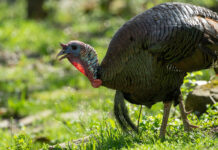
I have heard it all.
“Livestock guardian dogs will kill other dogs. They should be removed any time you use herding dogs and should never be introduced to any pet dogs.”
“If your pet dog ever gets loose and goes after the stock, your LGD will not stop them if they are friends.”
“Herding dogs are obviously a threat because they chase stock.”
This seems to be the consensus on the threat assessment skills of your basic livestock guardian. It is what I was told, and it represents the majority of the answers you will get if you ask this question on most forums.
The idea that every dog should be livestock safe, within the constraints of their mental capacity, seems to be a foreign concept these days. I have both pet and herding dogs here — two Australian cattle dogs, one Pomeranian and a rotating group of fosters. I expect them all to coexist with the LGDs peacefully, to some degree or another.
Herd vs. chase
What does that look like? One of the most important things I learned in my quest for a herding dog is the difference between “herd” and “chase.”
It’s a hardwired trait, and has a distinct impact on the way my livestock guardians view the work the herding dogs are doing. The response of the stock is also a good indicator of the drive behind a dog’s actions. My animals are not afraid of the cattle dogs. When we are not working they can move among the stock without issue.
When we started out, I asked my LGDs to heel while we worked the stock. This is where basic obedience comes in handy. They had a chance to observe and learn about this new activity, and to see that we were only moving sheep from one pasture to the next.
In the beginning, when I released the livestock guardians, they would move to check the stock over, confirming that no one was any worse for the wear. As they became more comfortable, I only called the younger dogs to heel. Seven, the oldest one, remained loose.
Learning the pattern
Her first day, Seven hung around the edges and continued to observe. I corrected some mild blocking of the herding dog from younger stock. It didn’t take Seven long to figure out that the stock were going through the gate where I stood.
Just a few days into being left on her own, she took the lead as soon as I sent out the dogs and started calling stock, leading them to the gate, the cattle dogs bringing up the rear. As the younger dogs were allowed back in, they instinctively took up positions in and around the stock.
Every day, we move the sheep from their small corral up at the house, and travel about a quarter of a mile to various grazing areas. At this stage of the game, everyone knows their jobs. Each time something changes, they instinctively shuffle to accommodate that change.
When we first added a third LGD to the sheep group, I kept the young dog at heel, my oldest led out, and the teen moved up to flank the line as we made our way to the grazing areas. Now that the youngest has it down, he has switched to flank the line, and my teen dropped back to tail position with me.
On the way home at night, the teen leads out, the youngster flanks and my oldest brings up the rear with me. By their design, the oldest is always in the position where we are most likely to see a problem, and the youngest in the middle with the stock.
I recently added a second cattle dog. It will be interesting to see how things change again as her training progresses.
The expectations I have for all of the animals — as well as the communication, trust and the training I do with them — allow me to work with them as seamlessly as possible.
I am the shepherd. I am the line.













Thank you! This is reassuring and exactly what I expected.
Herding is co-opted stalking and chase behavior.
I expect the general cautions you mention come from many instances of LGDs killing herding dogs. But yeah, they are quite smart about determining what actually is and is not a threat. But if they aren’t given a structured, initially supervised opportunity to figure that out, accidents could happen.
My Anatolian girl isn’t even a working dog, but I have no doubt she would be enraged by the site of a collie working. She hates anything that looks roughly like chasing — like she goes berserk when she sees a guy in the neighborhood who has his pit bull pull him on his skateboard. :-)
This sounds more like OCD “fun police” than protecting.
Is this still an active website? I have questions about my LGD (great pyr puppy, 6wks) and my menagerie of house dogs. I’ve rescued dogs for years, and I don’t want my LGD to lose it when they have to pass the barnyard fence. They have their own yard, but the 1/2 acre area where my barn animals stay views the cars.
Will he want to kill them on sight when he’s older? Should he mingle with them a little? I didn’t realize just how much information online would conflict. Some say they should never meet, some say let them socialize some. All say not to confuse puppy about who to protect.